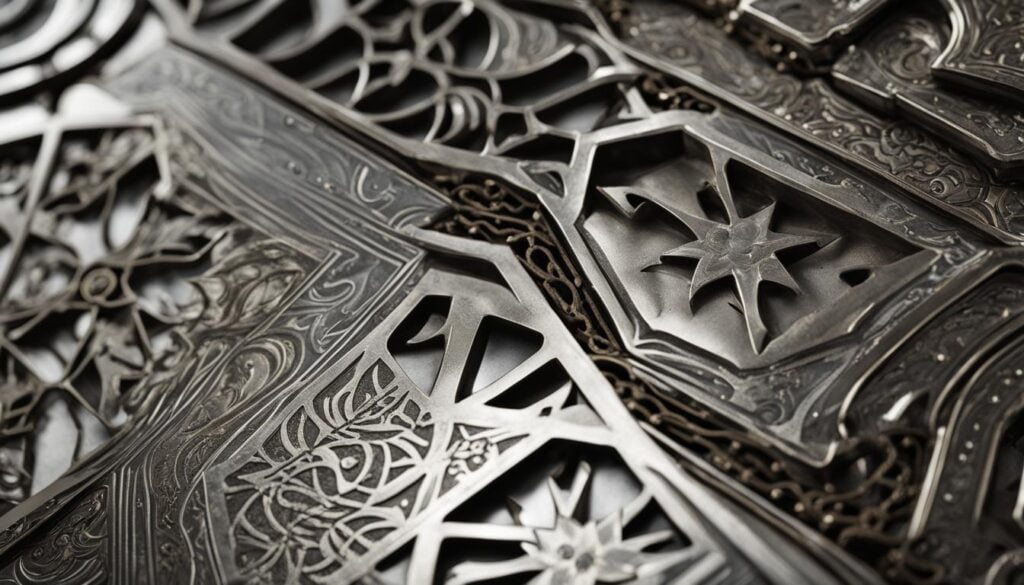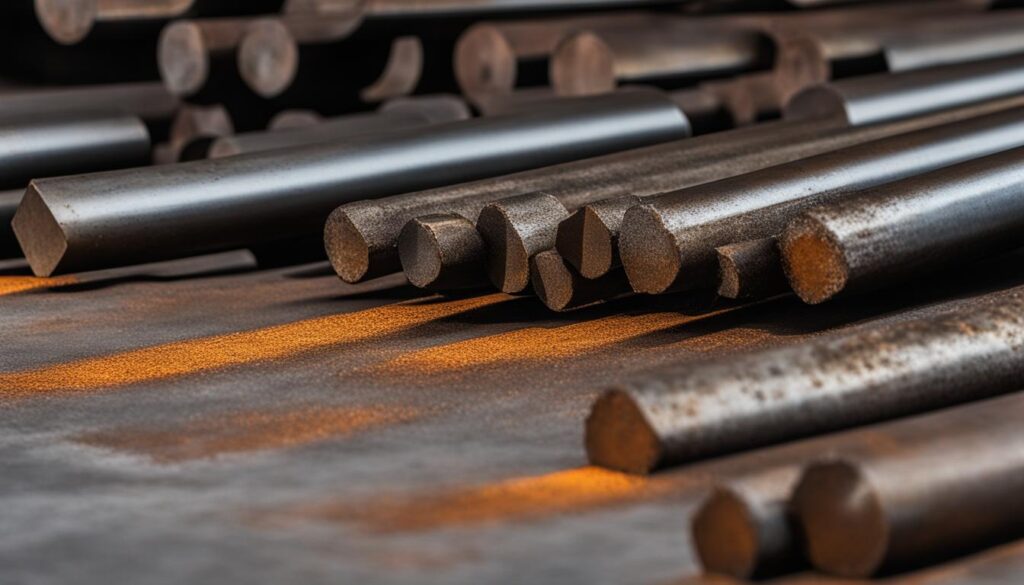Our alloy steel castings, such as those produced at KT-Foundry, are engineered to offer superior corrosion resistance, making them ideal for a variety of industrial applications. One of the main factors contributing to the outstanding corrosion resistance of our alloy steel is the careful alloy composition, which includes elements like chromium that forms a protective oxide layer on the steel’s surface. This layer shields the metal from oxygen penetration, significantly reducing rust and maintaining structural integrity and longevity in the components we manufacture.
Key Takeaways
- Corrosion resistance is a vital property of alloy steel castings, contributing to their longevity and durability in various environments.
- Our alloy steel castings at KT-Foundry are designed to resist environmental degradation.
- Chromium is a key alloying element, forming a protective oxide layer on the steel to prevent rust.
- The careful alloy composition enhances the corrosion resistance of our alloy steel products.
- Alloy steel castings are ideal for countless industrial applications due to their robustness against harsh environments and corrosive substances.
Understanding Corrosion Resistance in Alloy Steel
Corrosion resistance in our alloy steel castings is achieved through a careful balance of alloying elements that react with the environment to form a protective barrier. The presence of chromium is particularly significant as it aids in the creation of a chromium oxide layer, also known as passivation, which is crucial for resisting oxidation and rust.  While it’s possible for all metals, including stainless steel, to corrode under certain conditions, the selection of appropriate alloy compositions, as we practice at KT-Foundry, ensures optimal performance for the intended application.
While it’s possible for all metals, including stainless steel, to corrode under certain conditions, the selection of appropriate alloy compositions, as we practice at KT-Foundry, ensures optimal performance for the intended application.
Understanding the types of corrosion, such as galvanic or crevice corrosion, and the conditions under which they occur is fundamental in the development of our corrosion-resistant alloy steel castings. We explore various corrosion types to ensure a comprehensive understanding of the environmental reactions and alloy steel properties needed to combat corrosion.
- Uniform Corrosion
- Galvanic Corrosion
- Pitting Corrosion
- Crevice Corrosion
- Intergranular Corrosion
- Stress Corrosion Cracking
Uniform corrosion occurs when the material’s entire surface is exposed to an oxidizing environment and is characterized by a uniform thinning of the surface layer. Galvanic corrosion results from two or more dissimilar metals coming into contact in an electrolytic solution, and pitting corrosion is localized metal loss in small areas exposed to aggressive environments.
An in-depth understanding of corrosion phenomena and environmental factors allows our engineers at KT-Foundry to identify potential weaknesses in alloy steel castings and take the necessary steps to enhance their corrosion resistance.
Incorporating adequate chromium content in the alloy composition is essential for producing a stable chromium oxide layer, which in turn enables effective passivation. The table below illustrates various chromium contents and their implications for corrosion resistance:
| Chromium Content (%) | Corrosion Resistance |
|---|---|
| 10-12 | Basic corrosion resistance |
| 12-18 | Good corrosion resistance |
| 18-26 | Very good corrosion resistance |
| 26+ | Outstanding corrosion resistance |
In conclusion, the intricacies of corrosion resistance in alloy steel are governed by the alloying elements, especially chromium, used in the castings. By understanding the various corrosion mechanisms and the role of chromium oxide in passivation, we at KT-Foundry effectively design alloy steel compositions to deliver superior corrosion protection and longer service life for our castings across a multitude of applications.
Enhancing Corrosion Resistance Through Alloy Composition
Alloy steel’s corrosion resistance is considerably enhanced by precise additions of certain elements, notably chromium, nickel, and molybdenum which serve as the primary components in forming corrosion-resistant alloys (CRAs). At KT-Foundry, we utilize these elements to create alloy steel castings that withstand aggressive conditions.

The Role of Key Alloying Elements in Corrosion Resistance
The addition of elements like chromium, nickel, and molybdenum plays a pivotal role in the corrosion resistance of our alloy steel castings. Chromium is essential for forming a protective film on steel, which combats corrosive substances. The increasing presence of other aggressive compounds, such as chloride or sulfur, necessitates higher chromium levels. Nickel augments the mechanical properties and weldability of the steel and is vital in forming austenitic structures that contribute to flexibility and toughness. Molybdenum enhances the material’s ability to withstand high-temperature environments and increases resistance to crevice and pitting corrosion.
The Emergence of Corrosion-Resistant Alloys (CRAs) in Industry
CRAs have become indispensable in industrial applications due to their robustness against harsh environments. With a base requirement of over 50% alloy like Inconel 625, these materials are designed to face challenges such as high temperatures, aggressive chemicals, and mechanical stress. CRAs are employed in subsea valves, actuators, and oil and gas well tubing and casing, where their unique compositions with elements like chromium, nickel, molybdenum, and others provide them with the necessary strengths to withstand the demands of such applications.
Case Studies: Success Stories of Alloy Steels in Harsh Environments
“Martensitic stainless steels, for instance, show remarkable success in oilfield applications due to their hardenability and strength derived from the heat treatment process.”
Duplex stainless steels excel in structural applications like bridges and buildings due to their combination of austenitic and ferritic properties. High-strength, low-alloy (HSLA) steels further demonstrate this success through exceptional strength-to-weight ratios suitable for automotive, aerospace, and energy sectors.
| Alloy Steel Type | Industry Application | Key Characteristics |
|---|---|---|
| Martensitic Stainless Steel | Oilfield Applications | Hardenability, Strength |
| Duplex Stainless Steel | Structural Applications (Bridges, Buildings) | Austenitic & Ferritic Properties |
| High-Strength, Low-Alloy (HSLA) Steel | Automotive, Aerospace, Energy | Strength-to-Weight Ratio |
Conclusion
Alloy steel castings with enhanced corrosion resistance serve as pivotal components in the progression of modern industries, providing solutions that are both innovative and sustainable. At KT-Foundry, we remain at the forefront of this development by producing castings that fulfill the stringent demands of various sectors, ensuring that each casting is engineered for optimized performance, resilience, and longevity.
Through ongoing advancements in material science and the conscientious application of key alloying elements, we ensure that our products will continue to play an essential role in driving industrial progress and meeting future challenges. Our commitment to producing high-quality alloy steel castings with superior corrosion resistance is a testament to our dedication to maintaining exceptional standards of engineering and manufacturing.
As we forge ahead in our pursuit of industrial innovation and sustainability, we are confident that our products, like those from KT-Foundry, will maintain their crucial position in supporting the growth and progress of industries around the world.
FAQ
What is corrosion resistance in alloy steel castings?
Corrosion resistance refers to the ability of alloy steel castings, such as those produced by KT-Foundry, to withstand degradation in various environments. This property is crucial for maintaining structural integrity and longevity in the components and is achieved through a careful balance of alloying elements such as chromium, nickel, and molybdenum.
How is the corrosion resistance of alloy steel enhanced?
The corrosion resistance of alloy steel is enhanced by precisely adding alloying elements, notably chromium, nickel, and molybdenum. These elements serve as the primary components in forming corrosion-resistant alloys (CRAs), which can withstand aggressive conditions and maintain their structural integrity in demanding industrial settings.
What are the key alloying elements in corrosion-resistant alloy steel?
The key alloying elements in corrosion-resistant alloy steel include chromium, nickel, and molybdenum. Chromium is essential for forming a protective film on steel, nickel contributes to mechanical properties and weldability, and molybdenum enhances the material’s ability to withstand high-temperature environments and increases resistance to crevice and pitting corrosion.
What industries and applications benefit from corrosion-resistant alloys (CRAs)?
CRAs have become indispensable across a wide range of industries and applications due to their robustness against harsh environments. Some examples include subsea valves, actuators, oil and gas well tubing and casing, and structural applications like bridges and buildings. These materials excel in facing high temperatures, aggressive chemicals, and mechanical stress.
Can you provide some examples of successful alloy steel castings in harsh environments?
Some examples of successful alloy steel castings in harsh environments include martensitic stainless steels in oilfield applications, duplex stainless steels in structural applications like bridges and buildings, and high-strength, low-alloy (HSLA) steels in automotive, aerospace, and energy sectors. These materials offer exceptional strength-to-weight ratios suitable for their respective applications.


